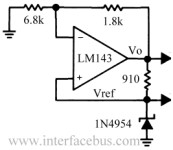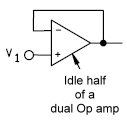General Engineering Terms
"A"
"B"
"C",
"D",
"E",
"F",
"G",
"H",
"I",
"J",
"K",
"L",
"M",
"N",
"O",
"P"
"Q",
"R",
"S",
"T",
"U",
"V",
"W",
"X",
"Y",
"Z"
Voltage Regulator Op Amp Design
This design uses an LM143 operational amplifier. There's nothing special about this device, and was selected because it could be considered a replacement for the common LM741 Op Amp. In fact the LM143 is a higher voltage upgrade to the LM741 [uA741]. Although any other general purpose operational amplifier developed after the 741 could be considered an up-grade.
For simplicity the supply voltage to the operational amplifier is not shown in the schematic. However only an Op Amp which may use a single voltage supply should be considered. So in this case V+ is connected to a positive voltage and V- is connected to ground. A by-pass capacitor should also be used across the power rail, but is also omitted from the diagram. |
 LM143 Voltage Regulator |
The diode is a 1N4954 Zener Diode with a zener voltage [Vz] of 6.8 volts. Although almost any Zener diode could be used, and would depend on the actual voltage required on the output of the circuit. So the example diode used here is just a random example, just as the selection of the LM143 is random.
The output shown at the top of the diode is the zener voltage, and will be what ever diode voltage is used or required. So the point is fixed, depending on the Zener voltage of the diode selected. The [910] series resistor is used to select the current through the diode.
The input resistor [6.8k] and the feedback resistor [1.8k] are used to scale the output to the desired voltage:
Vo = 6.8 * (Ri + Rf)/ Ri.
In this case using the component values provided:
Vref = 6.8 volts & Vo = 8.6 volts.
Output Voltage Polarity
The polarity of the output voltage is positive, based on the direction of the zener diode. However if the zener diode is reversed, and the Op Amp is power from a negative voltage [and ground], than the circuit will be a negative voltage regulator.
Editor note; this topic is for informational purposes, to show how to develop a voltage regulator using an Op Amp. However; there is absolutely no need to design a voltage regulator circuit using an operational amplifier. There are many different styles of voltage regulator ICs available to cover any particular need. Along with all the different options available, come the many different packaging styles as well.
But there could be some obscure chance that a spare operational amplifier, already being used in another part of the design is free. Or that a particular Op-Amp is already being used in the parts list and could be re-purposed as a voltage regulator, there by not requiring a new line item on the PL. In any case the LM143 is offered here to represent one possible circuit design which utilizes an OpAmp.
The LM143 is depicted here to illustrate a general purpose operational amplifier used in this application. In this case the LM143 is being offered as a high voltage replacement for an LM741 Op-Amp, or in other words almost any other Op Amp.
Operational Amplifier Circuit Designs
LM386: Audio Mono Amplifier
LM741: Audio Stereo Amplifier
LM149: Audio Tone Control Filter
LM301: Audio 2-Band Tone Control Filter
TL082: Audio 3-Band Tone Control Filter
LM741: Audio Midrange Control Filter
LM381: Audio Mixer [Summer]
LM741: Audio Equalizer [Filter]
LM741: Resonant Equalizer [Filter]
LM741: All-pass Filter
LM101: Sine Wave Oscillator
LM107: Sine Wave Oscillator
LM108: Cosine Wave Oscillator
LM107: Triangle Wave Oscillator
LM3900: Triangle Wave Oscillator
LM124: Pulse Generator
The list of operational amplifier designs does not include all the different Op Amp circuits on this site. Nor does it include all of the different Op Amp devices that are used in the circuits. The list only serves as a starting point showing some common circuit examples and the Op Amp used to implement them.









